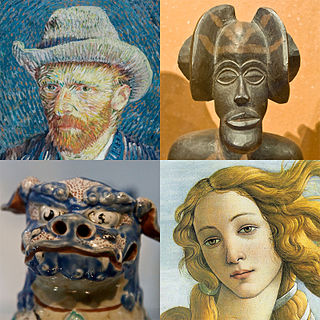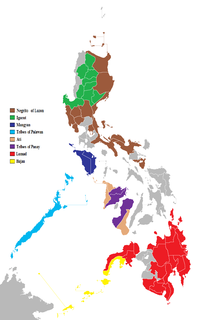
Petroglyphs are images created by removing part of a rock surface by incising, picking, carving, or abrading, as a form of rock art. Outside North America, scholars often use terms such as "carving", "engraving", or other descriptions of the technique to refer to such images. Petroglyphs are found worldwide, and are often associated with prehistoric peoples. The word comes from the Greek prefix petro-, from πέτρα petra meaning "stone", and γλύφω glýphō meaning "to carve", and was originally coined in French as pétroglyphe.

Indigenous Australian art or Australian Aboriginal art is art made by the Indigenous peoples of Australia and in collaborations between Indigenous Australians and others. It includes works in a wide range of media including painting on leaves, wood carving, rock carving, sculpting, ceremonial clothing and sand painting. This article discusses works that pre-date European colonisation as well as contemporary Indigenous Australian art by Aboriginal Australians. These have been studied in recent years and have gained much international recognition.

The culture of the Philippines is a combination of cultures of the East and West. Filipino identity was created primarily as a result of pre-colonial cultures, colonial influences and foreign traders intermixing together; gradually evolving into a uniquely Filipino identity. In pre-colonial times, the Philippines was a divided set of nations, islands and tribes being ruled by their own kings, chieftains, lakans, rajahs, datus and sultans. Every nation has its own identity and some are even part of a larger empire outside of what is now the Philippines. Manila, for example, was once part of the Islamic Sultanate of Brunei, while many parts of Mindanao is theorized to be part of the Hindu Majapahit Empire, with its capital being located in East Java in modern-day Indonesia. The advent of colonial rule in the islands marked the beginning of The Philippines as a colony that would later evolved into a country after independence, a collection of Southeast Asian countries united under Spain. Chinese influence has been felt throughout Southeast Asia through trade, even before the colonization of the region; specifically by the Ming dynasty and other earlier dynasties, from as early as the 9th century. But it was during Spanish colonization that Chinese influence truly left their mark on what is now the Philippines. The blending of indigenous, colonial and external influence is very evident in the historic arts and traditions of the Philippines.
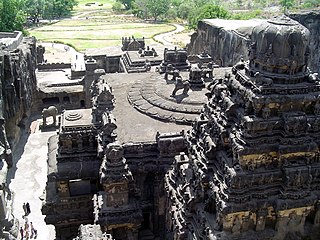
Ellora is a UNESCO World Heritage Site located in the Aurangabad district of Maharashtra, India. It is one of the largest rock-cut monastery-temple cave complexes in the world, featuring Buddhist, Hindu and Jain monuments, and artwork, dating from the 600-1000 CE period. Cave 16, in particular, features the largest single monolithic rock excavation in the world, the Kailasha temple, a chariot shaped monument dedicated to Shiva. The Kailasha temple excavation also features sculptures depicting the gods, goddesses and mythologies found in Vaishnavism, Shaktism as well as relief panels summarizing the two major Hindu Epics.

The Longmen Grottoes or Longmen Caves are some of the finest examples of Chinese Buddhist art. Housing tens of thousands of statues of Buddha and his disciples, they are located 12 kilometres (7.5 mi) south of present-day Luoyang in Henan province, China. The images, many once painted, were carved as outside rock reliefs and inside artificial caves excavated from the limestone cliffs of the Xiangshan (香山) and Longmenshan, running east and west. The Yi River flows northward between them and the area used to be called Yique. The alternative name of "Dragon's Gate Grottoes" derives from the resemblance of the two hills that check the flow of the Yi River to the typical "Chinese gate towers" that once marked the entrance to Luoyang from the south. There are as many as 100,000 statues within the 2,345 caves, ranging from 1 inch (25 mm) to 57 feet (17 m) in height. The area also contains nearly 2,500 stelae and inscriptions, hence the name “Forest of Ancient Stelae", as well as over sixty Buddhist pagodas. Situated in a scenic natural environment, the caves were dug from a 1 kilometre (0.62 mi) stretch of cliff running along both banks of the river. 30% date from the Northern Wei and 60% from the Tang dynasty, caves from other periods accounting for less than 10% of the total. Starting with the Northern Wei Dynasty in 493 AD, patrons and donors included emperors, Wu Zetian, members of the royal family, other rich families, generals, and religious groups.

In archaeology, rock art is human-made markings placed on natural stone; it is largely synonymous with parietal art. A global phenomenon, rock art is found in many culturally diverse regions of the world. It has been produced in many contexts throughout human history, although the majority of rock art that has been ethnographically recorded has been produced as a part of ritual. Such artworks are often divided into three forms: petroglyphs, which are carved into the rock surface, pictographs, which are painted onto the surface, and earth figures, formed on the ground. The oldest known rock art dates from the Upper Palaeolithic period, having been found in Europe, Australia, Asia and Africa. Archaeologists studying these artworks believe that they likely had magico-religious significance.

The history of Asian art or Eastern art, includes a vast range of influences from various cultures and religions. Developments in Asian art historically parallel those in Western art, in general a few centuries earlier. Chinese art, Indian art, Korean art, Japanese art, each had significant influence on Western art, and, vice versa. Near Eastern art also had a significant influence on Western art. Excluding prehistoric art, the art of Mesopotamia represents the oldest forms of Asian art.

The Cosquer cave is located in the Calanque de Morgiou in Marseille, France, near Cap Morgiou. The entrance to the cave is located 37 m (121 ft) underwater, due to the Holocene sea level rise. The cave contains various prehistoric rock art engravings. It was discovered in 1985 by and named after diver Henri Cosquer, but its existence was not made public until 1991, when three divers became lost in the cave and died.

Arborglyphs, dendroglyphs, silvaglyphs, modified cultural trees, or aspen carvings are tree carvings made in the bark of aspen trees by shepherds, many of them Basque and Irish American, throughout the Western United States. They have been documented across northern California and in areas such as Boise, Idaho and Steamboat Springs, Colorado. A grove of aspens with Basque arborglyphs in the Steens Mountain region of southeastern Oregon have been designated as Oregon Heritage Trees.

The Badami cave temples are a complex of four Hindu cave temples located in Badami, a town in the Bagalkot district in northern part of Karnataka, India. The caves are considered an example of Indian rock-cut architecture, especially Badami Chalukya architecture, which dates from the 6th century. Badami was previously known as Vataapi Badami, the capital of the early Chalukya dynasty, which ruled much of Karnataka from the 6th to the 8th century. Badami is situated on the west bank of a man made lake ringed by an earthen wall with stone steps; it is surrounded on the north and south by forts built in later times.
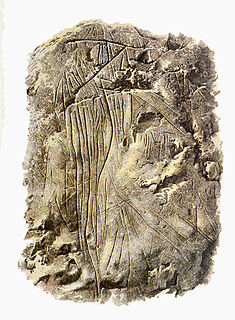
Badanj Cave is located in Borojevići village near the town of Stolac, Bosnia and Herzegovina. This rather small cave has come to public attention after the 1976 discovery of its cave engravings, that date to between 12,000 and 16,000 BCE.

The Pomier Caves are a series of 55 caves located north of San Cristobal in the south of the Dominican Republic. They contain the largest collection of rock art in the Caribbean created since 2,000 years ago primarily by the Taíno people but also the Carib people and the Igneri, the pre-Columbian indigenous inhabitants of the Bahamas, Greater Antilles, and some of the Lesser Antilles. These caves have been damaged by the uncontrolled mining of limestone nearby.

Sydney rock engravings, or Sydney rock art, are a form of Australian Aboriginal rock art in the sandstone around Sydney, New South Wales, Australia, that consist of carefully drawn images of people, animals, or symbols. Many thousands of such engravings are known to exist in the Sydney region, although the locations of most are not publicised to prevent damage by vandalism, and to retain their sanctity, as they are still regarded as sacred sites by Indigenous Australians. There are two art environments in Sydney Basin, rock shelters and engraving sites.

The art of the Philippines refers to the works of art that have developed and accumulated in the Philippines from the beginning of civilization in the country up to the present era. It reflects to its society and non-Filipinos the wide range of cultural influences on the country's culture and how these influences honed the country's arts. The art of the Philippines can be divided into two distinct branches, namely, traditional arts, and non-traditional arts. Each branch is further divided into various categories with subcategories.

In the Chatham Islands of New Zealand, the indigenous Moriori people practised the art of momori rakau, or tree carving.
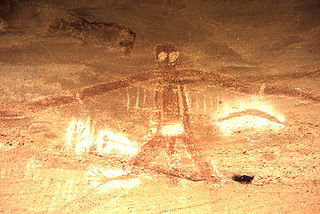
Aboriginal sites of New South Wales consist of a large number of places in the Australian state of New South Wales where it is still possible to see visible signs of the activities and culture of the Australian Aboriginals who previously occupied these areas.
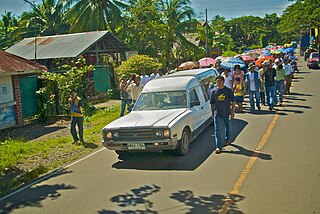
During the Pre-Hispanic period the early Filipinos had already believed in a concept of life after death. This belief in an afterlife prompted the Filipinos to create burial customs and beliefs to somehow honor the dead through rituals. Due to different cultures from different part of the Philippines, many different burial practices have also emerged from the different tribes. For example, The Manobos had to bury their dead in trees, the Ifugaos had to seat their corpse on a chari before it was brought to a cave and buried elsewhere. The present day Filipinos had retained the belief of life after death from their ancestors. Which is why it is only customary for the present day Filipino to also honor the dead through different practices. Most prominent practice of honoring the dead is by holding a wake as way for the loved ones to properly mourn the death of one that is dear to them. Most Filipino Christians hold the wake at the funeral homes but others also hold them at their own household wherein the wake would be held for three to seven days and the family members would be required to wear either black or white during the procession. Unlike their Christian brethren, Filipino Muslims are required to bury the dead 24 hours after the time of death. This custom dates back to when the spread of disease was a prominent risk, the Muslims prompted to bury the corpse as soon as possible for sanitary reasons such as avoiding the widespread disease that could come from the rotting corpse. One thing that would be common between these two systems is that both practices believe in mourning even after the burial. In the case of Filipino Muslims, the mourning period lasts 40 days, during which they are required to wear black clothing. Filipino Christians have the "waksi", or death anniversary, and mourning on the 40th day.

The Cantabrian caves' unique location make them an ideal place to observe the settlements of early humans thousands of years ago. The magnificent art in the caves includes figures of various animals of the time such as bison, horses, goats, deer, cattle, hands and other paintings. Archaeologists have found remains of animals such as bears, the remains of arrows and other material indicating a human presence; these artifacts are now found mostly in the Regional Museum of Prehistory and Archaeology of Cantabria.
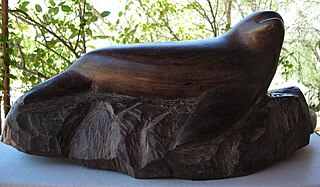
Mexican ironwood carving is a Mexican tradition of carving the wood of the Olneya tesota tree, a Sonora Desert tree commonly called ironwood.

Biak-na-Bato National Park is a protected area of the Philippines located almost entirely within Barangay Biak-na-Bato in San Miguel, Bulacan from where it derives its name. The park also extends to the nearby municipalities of San Ildefonso and Doña Remedios Trinidad covering a total area of 2,117 hectares. It was declared a national park in 1937 by President Manuel Luis Quezon by virtue of its association with the history and site of the Biak-na-Bato Republic. The park consists of a cave network and a system of rivers and trails of both historical and ecological importance. Situated only 80 kilometers northeast from Manila, it is fast becoming a popular weekend eco-adventure destination for the city dwellers.
